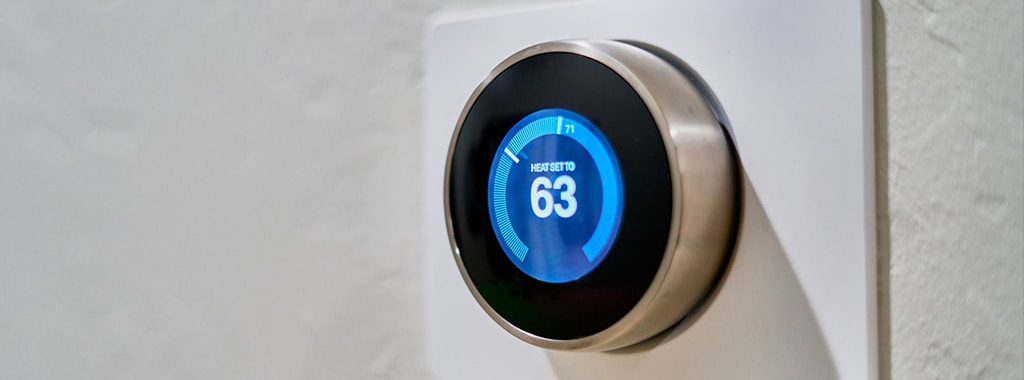The summer months usher in fun times with family and long, hot days. As temperatures rise, a lot of the time, so do your air conditioning costs. But there are plenty of methods ranging from quick fixes to long-term solutions to cut down on your cooling bill.
Let’s take a look at them!
How to Reduce Air Conditioning Costs Today
You can start cutting back on cooling costs as soon as today!
Here’s the bottom line: the smaller the difference between the temperature inside and outside of your home, the lower your bill will be. There are plenty of minor lifestyle changes and considerations you can implement to achieve this.
1. Turn The Heat Up
If you have a programmable air conditioning system, keep the temperature as high as you can handle. When you leave your house, turn it up about 5 degrees higher to get the temperature inside and outside even closer – just don’t keep it above the outside temperature.
If you’re attempting to cool down your home faster, try to stay away from setting the inside temperature lower than you intend to keep it regularly. It doesn’t actually save you much time and you may run the risk of forgetting to set it to your normal temperature again.
2. Reduce Heat-Creating Activities
Our home appliances create a lot more warmth than we may think. Another method to keep your home cool for cheap is to cut back on heat-creating activities during the day. Avoid using your dryer, stovetop, and dishwasher during the heat of the day.
Instead, explore outdoor alternatives such as using a clothing line or grilling. Some other activities you may want to reduce during the day include showering for long durations, keeping the television on, and at-home workouts (try using a fan instead).
3. Don’t Crowd Into One Room
In a confined space, multiple people crammed together can significantly heat up a room. Your body can radiate around 100 watts of excess heat. This can make for an uncomfortable increase in heat in an already toasty room during the summer. If you have guests over, try spacing out as much as possible during the daytime when the temperature is at its hottest.
4. Use a Fan
A steadfast tool to beat the heat is the ceiling or circulating fan. In reality, fans don’t lower the temperature of a room. They make you feel cooler through a phenomenon known as the wind-chill effect. As the air circulates, you’ll feel several degrees cooler. Fans work especially well in combination with your air conditioner, moving the cool air throughout a room more efficiently. Be sure your ceiling fan is rotating counterclockwise so that the blades push cooler air down while the A/C is on.
5. Draw the Curtains
Curtains, blinds, and shades are more strong allies in your quest for a lower electric bill. You’ll notice a significant difference in the temperature of your home if you allow sunlight to beam through your windows. Keeping your curtains drawn can significantly reduce the temperature of your home. Especially if they are light in color. According to the Department of Energy, “medium-colored draperies with white, plastic backings can reduce heat gains by 33%.”
6. Don’t Let Your Cool Air Escape
The last thing you want is to lose all the cold air your air conditioner worked so hard to create. Another important rule of thumb is to keep your doors and windows closed while your A/C is running. This one is easy to implement and something you can do today. Be sure to check for potential bad seals or leaks. This leads us to some more involved fixes you can work towards for a lower cooling bill.
7. Keep Your A/C On All Day
If you feel way too hot and the tip of keeping the temperature up isn’t an option, keep the air conditioner on at all times of the day. Although it seems counterintuitive, leaving your A/C on all day is another great way to save on your cooling bill.
When you turn your system off and let your house heat up too much, it takes up a lot of energy for your A/C to get the temperature back down again once you turn it back on. It can also put a lot of undue stress on your system to make this a regular habit.
What Are Some Long-Term Ways to Reduce My A/C Bill?
The methods above are a great starting point for a cheaper, cooler home. But if you’re willing to invest more time and money in a solution, there are plenty of options to choose from.
1. Seal Your Windows and Doors
As mentioned before, potential leaks or bad seals aren’t doing you any favors in the quest for a cool home. Sometimes something as simple as a weather strip can prevent the flow of air. But, you might need to consider replacing an entire window if it’s more of a serious issue.
2. Seal Your Attic and Basement
Your windows and doors aren’t the only areas of concern when it comes to bad seals. Attics and basements can be another place where cool air escapes. This can be especially problematic in older homes. You can try your hand at a DIY fix by caulking leaks you may notice or, if you’re willing to spend a little more cash, you can hire a professional to air-seal these spaces.
3. Plant A Tree or Bush
Some other long-term fixes you can invest in are trees or bushes. Just as curtains block out the sun, plants can shield your home from the harsh rays. When deciding where to plant, consider placing tall trees on the south side of your home as it gets the most sun throughout the day.
4. Update to an Auto Thermostat
Auto thermostats are another great tool. As you already know by now, keeping the home as close to the temperature outside as possible is crucial to lowering your bill. With an auto thermostat, you can set your temperature preferences schedule once and it will automatically change. Some even connect to an app so you can change it while away from home!
5. Maintain Your A/C System
Even the most energy-efficient, technologically advanced A/C won’t save you money if you don’t maintain it properly. Take care of your air conditioning system. Be sure your air ducts aren’t blocked by furniture or dust. Periodically check the evaporator and condenser coils outside for debris and clean or switch out your filter once a month.
6. Call in the HVAC Professionals
A final step you can take to assure you’re saving as much money as possible is to hire a professional HVAC contractor to provide you with comprehensive air conditioning services. There could be underlying issues costing you money that you might not be able to detect on your own. That’s where we come in!
If you’re in Northern Colorado, take advantage of a free estimate when you call Good Guys Home Services. Escape the summer heat and save money with us today!















